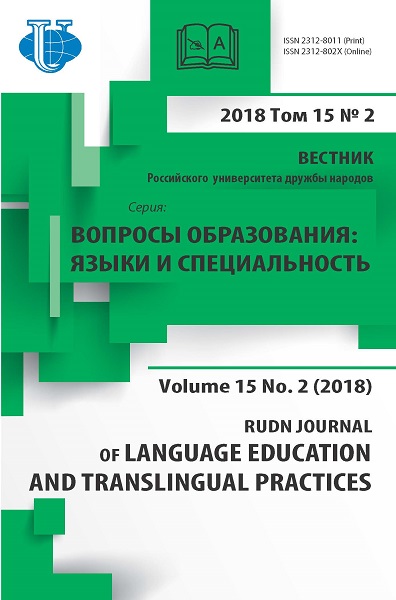Factors of National-English Translingualism in the Scandinavian Region
- Authors: Borodina D.S.1
-
Affiliations:
- Vernadski Crimea Federal University
- Issue: Vol 15, No 2 (2018)
- Pages: 255-262
- Section: LANGUAGES IN CONTACT: THEORY AND PRACTICE
- URL: https://journals.rudn.ru/polylinguality/article/view/18576
- DOI: https://doi.org/10.22363/2312-8011-2018-15-2-255-262
Cite item
Full Text
Abstract
The article dwells on factors of the “presence” of English in the cognate languages of the Scandinavian region where a common translingual situation has evolved. The “presence” of English is argued to be a case of translingualism resulting from interaction of English and Scandinavian languages superficially visible through the processes of borrowing and code shifting. The data collected from internet interviews of Nordic speakers is claimed to demonstrate that abundance of anglicisms and code shifts in their translingual communication testifies for the vitality of Scandinavian languages.
About the authors
Darya Sergeyevna Borodina
Vernadski Crimea Federal University
Author for correspondence.
Email: dasha_tnu@mail.ru
Candidate in Philology, Associate Professor of Foreign Languages Department
4, Vernadskogo Av., Simferopol, Crimea, Russian Federation, 95000References
- Proshina, Z.G. 2016. “Problemy i perspektivy translingval’nyhi transkul’turnyh kontaktov(vvedenie k tematicheskomu vypusku zhurnala)” [Problems and Perspectives of Translingual and Transcultural Contacts (Introduction to Thematic Issue of the Journal]. Social’nye i gumanitarnye nauki na Dal’nem Vostoke. 2 (50): 6—9. Print. (in Russ.)
- Proshina, Z.G. 2017. “Translingvizm i ego prikladnoe znachenie” [Translingualism and its Application]. RUDN Journal of Language Education and Translingual Practices. 14 (2): 155—170. Print. (in Russ.)
- Höglin, R. 2002. Engelska språket som hot och tillgång i Norden [The English Language as a Threat and an Asset in the Nordic Countries]. English Tema Nord Språksamarbete: 561, Nordiska Ministerrådet. Print.
- Graedler, A.-L. 2004. “Modern Loanwords in the Nordic Countries. Presentation of a project”. Nordic Journal of English Studies. 3: 5—21.
- Johansson, S., and A.-L Graedler. 2002. Rocka, hipt og snacksy. Om engelsk norsk språk og samfunn [Rocka, Hipt and Snacksy. About English Norwegian Language and Society]. Kristiansand: Høyskoleforlaget. Print.
- Jarvad, P. 1995. Nye ord. Hvorfor og hvordan? [New Words. Why and How?] København: Gyldendal. Print.
- Melin, T. English is not a Threat to Swedish. News and Events. University of Gothenburg, The Faculty of Arts. Sep 24, 2010. Available at: http://hum.gu.se/english/current/news/Nyhet_detalj/ english-is-not-a-threat-to-swedish.cid954946 (accessed: 14.06.2017).
- Sørensen, K. 1997. A Dictionary of Anglicisms in Danish. Historisk-filosofiskeskrifter. Copenhagen: Royal Danish Academy of Sciences and Letters. Print.
- Gottlieb, H. 2004. Danish echoes of English. Nordic Journal of English Studies. 3: 39—65. Print.
- Preisler, B. 2005. Deconstructing ‘the Domain of Science’ as a Sociolinguistic Entity in EFL Societies: The relationship between English and Danish in higher education and research // Preisler B., et al. (eds.). The Consequences of Mobility: Linguistic and Sociocultural Contact Zones. Roskilde: Roskilde University. Print.
- Preisler, B. 1999. Functions and Forms of English in a European EFL country. Bex T., Watts R. (eds.) Standard English: The Widening Debate. London: Routledge. Print.
- Why are Scandinavian People Incorporating English Sentences into Their Normal Speaking? Request Answers — Quora. 17.06.2015. Available at: https://www.quora.com/Why-areScandinavian-people-incorporating-English-sentences-into-their-normal-speaking (accessed: 15.06.2016).















